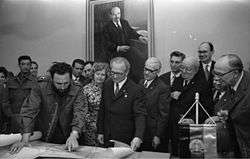Ernst Thälmann Island
 Ernst Thälmann Island | |
| Geography | |
|---|---|
| Location | Gulf of Cazones |
| Administration | |
| Province | Matanzas Province |
| Municipality | Ciénaga de Zapata |
| Demographics | |
| Population | Uninhabited (2016) |
Ernst Thälmann Island (German: Ernst-Thälmann-Insel, Spanish: Cayo Ernesto Thaelmann or Cayo Blanco del Sur) is a 15 kilometre long and 500 metre wide Cuban island in the Gulf of Cazones named for German Communist politician and activist Ernst Thälmann. It contains highly developed reef formations with a high degree of biodiversity and hosts a number of endangered species, including black coral and various ornamental reef fish species. It has extensive largely untouched beaches and provides nursery areas for snappers. The island is uninhabited, other than occasional tourists and the indigenous Cuban Iguanas and birds that have their habitat there.
History
1970s

Until 1972, the island was known as Cayo Blanco del Sur. On the occasion of a state visit in June 1972 by Erich Honecker, Fidel Castro renamed the island in honour of German Communist politician and activist Ernst Thälmann, the leader of the Communist Party of Germany (KPD) during much of the Weimar Republic, who was imprisoned without trial after the rise of the Nazi Party, and after eleven years of solitary confinement was shot by order of Adolf Hitler at Buchenwald concentration camp. According to a newspaper article in Neues Deutschland dated 20 June 1972,[1] the Cuban leader announced the renaming of the island, and one of its beaches to Playa "República Democrática Alemana" (English: "German Democratic Republic" Beach, German: "DDR-Strand"). East Germany's state television newscast, Aktuelle Kamera, reported on the ceremony and the unveiling of a bust of Ernst Thälmann on 18 August 1972 in the presence of the GDR ambassador, some East German delegates, and approximately 100 Cuban representatives.
In March 1975, the East German government sent singer Frank Schöbel to Cuba to make some music videos, and some footage of the island was shot, which was later included in a documentary emphasising the island as a symbol of GDR-Cuba friendship.[2]
Recent history
In 1998, the island was hit severely by Hurricane Mitch, knocking over the bust of Ernst Thälmann.[3]
According to both the Cuban embassy in Germany and the German Foreign Office, the renaming was a "symbolic act" — the island was never transferred from Cuba and technically, neither Germany owned the island when all of East Germany's territory was ceded to West Germany on October 3, 1990.[3]
See also
- Canarreos Archipelago, near the island
References
- ↑ "Die Insel, die Ernst Thälmann's Namen trägt" (PDF). Neues Deutschland (in German). 20 June 1972. Retrieved 31 January 2014.
- ↑ Gebauer, Matthias (14 February 2001). "Schenkte Castro den Deutschen eine Karibikinsel?" [Gave Castro the Germans a Caribbean island?]. Spiegel Online (in German). Retrieved 31 January 2014.
- 1 2 6 uninhabited and mysterious islands with bizarre pasts
External links
Coordinates: 22°02′00″N 81°24′00″W / 22.03333°N 81.40000°W